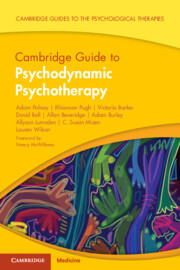Book contents
- Cambridge Guide to Psychodynamic Psychotherapy
- Cambridge Guides to the Psychological Therapies
- Reviews
- Cambridge Guide to Psychodynamic Psychotherapy
- Copyright page
- Dedication
- Contents
- Foreword
- Preface
- A Note from the Series Editor
- Acknowledgements
- Part 1: An Overview of the Model
- Chapter 1 An Historical Overview of Psychodynamic Psychotherapy
- Chapter 2 The Supporting Theory of Psychodynamic Psychotherapy
- Chapter 3 A Brief Description of the Empirical Basis of Psychodynamic Psychotherapy
- Chapter 4 An Outline of Psychodynamic Psychotherapy
- Part 2: The Model of Psychodynamic Psychotherapy into Practice
- Part 3: Application for Mental Health Presentations
- Part 4: Application of Psychodynamic Psychotherapy in Different Populations and in Different Settings
- Glossary of Terms
- Index
- References
Chapter 1 - An Historical Overview of Psychodynamic Psychotherapy
from Part 1: - An Overview of the Model
Published online by Cambridge University Press: 25 August 2023
- Cambridge Guide to Psychodynamic Psychotherapy
- Cambridge Guides to the Psychological Therapies
- Reviews
- Cambridge Guide to Psychodynamic Psychotherapy
- Copyright page
- Dedication
- Contents
- Foreword
- Preface
- A Note from the Series Editor
- Acknowledgements
- Part 1: An Overview of the Model
- Chapter 1 An Historical Overview of Psychodynamic Psychotherapy
- Chapter 2 The Supporting Theory of Psychodynamic Psychotherapy
- Chapter 3 A Brief Description of the Empirical Basis of Psychodynamic Psychotherapy
- Chapter 4 An Outline of Psychodynamic Psychotherapy
- Part 2: The Model of Psychodynamic Psychotherapy into Practice
- Part 3: Application for Mental Health Presentations
- Part 4: Application of Psychodynamic Psychotherapy in Different Populations and in Different Settings
- Glossary of Terms
- Index
- References
Summary
This chapter traces the origins of psychodynamic psychotherapy back to the late eighteenth century and to the development of ‘moral treatment’ by Pinel in Paris and William Tuke in York. It also considers the contribution of Mesmer’s theory of animal magnetism, and its revival as hypnotism in the second half of the nineteenth century by Jean-Martin Charcot and others. It then goes on to consider the work of Freud and the various critiques of his theories. Next the chapter considers the phenomenon of shell shock in the First World War and how it led to further developments in psychotherapy. It then looks at the creation of the Tavistock Clinic in the early twentieth century and the work of Anna Freud and Melanie Klein. Object relations theory is outlined, and the work of therapists such as Fairbairn, Bowlby, and Winnicott is examined. Finally the chapter briefly considers ‘the turn to the child’ in psychotherapy, the development of group psychotherapy, and the attempts to treat psychosis with psychotherapeutic methods.
Keywords
- Type
- Chapter
- Information
- Cambridge Guide to Psychodynamic Psychotherapy , pp. 1 - 17Publisher: Cambridge University PressPrint publication year: 2023



